All about the Meade ETX
A Buyer’s Guide
By Richard Day, Guest writer.
Which Meade ETX?
Without question, one of the largest selling telescope series in the world, the Meade ETX is a tremendously popular choice for a first telescope. However, there are many variations to choose from, so make sure you know as much as possible about the one you're bidding on/buying!
As there's more than one model, which one should you choose, and why? Here's what I think. This guide assumes you have a basic knowledge of Astronomical terms. I've kept it fairly straightforward.
Starting from the beginning:
ETX 90RA:
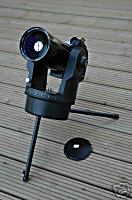 While now discontinued, the RA continues to provide first class views of the heavens. They still occasionally surface on Ebay, and can go for bargain prices! They are the simplest of the ETX family, in that they are not computer-controlled. They come standard with the Meade table tripod: a set of three legs which screw into the telescope base and will then polar align the scope. Once you have a reasonable polar alignment, the battery powered Right Ascension (RA - get it?) drive tracks at sidereal speed to keep your target in the eyepiece. I like the RA; these are great optics at a superb price. As no large tripod is required, the RA is an almost ideal travel scope. If in doubt, they can be identified by the long declination knob at the top of the right fork, and the two dials on the mount under the tube. As it's not Autostar equipped, you will need to learn your way around the sky on your own...but that's not a bad thing.
While now discontinued, the RA continues to provide first class views of the heavens. They still occasionally surface on Ebay, and can go for bargain prices! They are the simplest of the ETX family, in that they are not computer-controlled. They come standard with the Meade table tripod: a set of three legs which screw into the telescope base and will then polar align the scope. Once you have a reasonable polar alignment, the battery powered Right Ascension (RA - get it?) drive tracks at sidereal speed to keep your target in the eyepiece. I like the RA; these are great optics at a superb price. As no large tripod is required, the RA is an almost ideal travel scope. If in doubt, they can be identified by the long declination knob at the top of the right fork, and the two dials on the mount under the tube. As it's not Autostar equipped, you will need to learn your way around the sky on your own...but that's not a bad thing.
ETX 60:
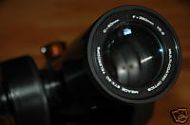 Seen for the first time by my eyes recently, this diminuitive member of the ETX family is a charmer. It shares very similar external dimensions as the ETX70, but requires a larger ring to anchor the objective into the oversize optical tube of the ETX 70. I think the ETX 60 really needs to be considered very much a beginners scope, as 60mm is quite a small aperture (finders of this size are not unusual). However, as with the ETX 70,it is a potentially useful all-round terrestrial/astronomical package. These were recently made available quite inexpensively in the US, and sold as 'backpack observatories.' This helps explain the current abundance of them on Ebay in the U.S.
Seen for the first time by my eyes recently, this diminuitive member of the ETX family is a charmer. It shares very similar external dimensions as the ETX70, but requires a larger ring to anchor the objective into the oversize optical tube of the ETX 70. I think the ETX 60 really needs to be considered very much a beginners scope, as 60mm is quite a small aperture (finders of this size are not unusual). However, as with the ETX 70,it is a potentially useful all-round terrestrial/astronomical package. These were recently made available quite inexpensively in the US, and sold as 'backpack observatories.' This helps explain the current abundance of them on Ebay in the U.S.
ETX 70:
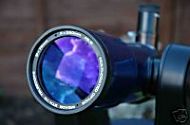 Also now discontinued, and replaced with the ETX 80, the ETX 70 gained a reputation for one of the best value computer guided scopes available. The lack of a viewfinder can sometimes make alignment a little tricky, but it's not too difficult. The 70 should really be considered a taster to see if you get the star bug. It can show you some detail on some of the planets, and a reasonable amount of deep sky objects. If the bug eludes you, the fast refractor optics mean it works well as a terrestrial scope too.
Also now discontinued, and replaced with the ETX 80, the ETX 70 gained a reputation for one of the best value computer guided scopes available. The lack of a viewfinder can sometimes make alignment a little tricky, but it's not too difficult. The 70 should really be considered a taster to see if you get the star bug. It can show you some detail on some of the planets, and a reasonable amount of deep sky objects. If the bug eludes you, the fast refractor optics mean it works well as a terrestrial scope too.
ETX 80:
The 80 replaced the 70, so many points remain the same. The slightly larger aperture contributes to a little more light grasp, it has a different tripod, and a built in barlow lens.
ETX 90:
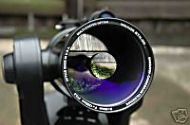 The plastic tube of the 70/80 is gone, and in its place a superb purple metal version. It's also much different on the inside: the refractor optics are gone, with Maksutov Cassegrain optics in their place. This means more magnification, and a narrower field of view (I won't touch on the Mak-Cass design any further. It will get too wordy, and there's loads of web info on it). The ETX 90 is widely considered the world's best selling telescope. ETX 90's have been, and continue to travel, everywhere. It's ultra portable, light, and small (so easily fits into hand baggage). It's a superb planetary scope, and handles deep sky objects reasonably well. The viewfinder is a little awkward (virtually impossible at the zenith), and eventually, the aperture may leave you wanting. A sometimes unique and quite surprisingly idiosyncratic telescope (mine sometimes sounds as if a mouse is driving the motors), it's unlikely that you would ever regret owning one.
The plastic tube of the 70/80 is gone, and in its place a superb purple metal version. It's also much different on the inside: the refractor optics are gone, with Maksutov Cassegrain optics in their place. This means more magnification, and a narrower field of view (I won't touch on the Mak-Cass design any further. It will get too wordy, and there's loads of web info on it). The ETX 90 is widely considered the world's best selling telescope. ETX 90's have been, and continue to travel, everywhere. It's ultra portable, light, and small (so easily fits into hand baggage). It's a superb planetary scope, and handles deep sky objects reasonably well. The viewfinder is a little awkward (virtually impossible at the zenith), and eventually, the aperture may leave you wanting. A sometimes unique and quite surprisingly idiosyncratic telescope (mine sometimes sounds as if a mouse is driving the motors), it's unlikely that you would ever regret owning one.
ETX 105:
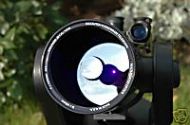 Introduced a few years later in the ETX timeline (the cover on the earlier manual features on the 90 & 125), the 105 utilises the motors from its bigger brother (the 125). For this alone, some people consider the 105 to be the optimum ETX. Its larger tube is handled easily by the beefier motors, and I've personally found them to often be the quietest ETX. The larger aperture starts to show off more deep sky objects, and more planetary detail is visible. The right angle finder is standard, and while also a bit challenging to figure out (as your other eye is unable to view the alignment star in question), it's a nice perk. It's also still reasonably portable (although you'll be pushing the flexibility of your airline's hand baggage limits). **The ETX 105 has now sadly been discontinued by Meade. A stronger seller in the UK than in the U.S., this has probably lead to its’ demise. Limited stocks are still available new in stores, but when they are gone, they're gone.
Introduced a few years later in the ETX timeline (the cover on the earlier manual features on the 90 & 125), the 105 utilises the motors from its bigger brother (the 125). For this alone, some people consider the 105 to be the optimum ETX. Its larger tube is handled easily by the beefier motors, and I've personally found them to often be the quietest ETX. The larger aperture starts to show off more deep sky objects, and more planetary detail is visible. The right angle finder is standard, and while also a bit challenging to figure out (as your other eye is unable to view the alignment star in question), it's a nice perk. It's also still reasonably portable (although you'll be pushing the flexibility of your airline's hand baggage limits). **The ETX 105 has now sadly been discontinued by Meade. A stronger seller in the UK than in the U.S., this has probably lead to its’ demise. Limited stocks are still available new in stores, but when they are gone, they're gone.
ETX 125:
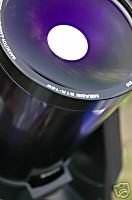 The Big Daddy of the ETX family, the 125 will surprise you at just how big it actually is! Its main disadvantage is its weight and bulk. It's not really cut out to be a travel scope the way its little brothers are (by the way, by travel scope, I mean something more elaborate than driving the car to Devon). However attractive, the 125 was not built to look at...it easily proves its worth when you look through it! The light grasp of the big 125mm aperture shows off the planets in fantastic detail, many double star observations are possible, and it performs very well on deep sky objects. Meade Mak-Cass optics are well respected, and the 125 shows them off in impressive style. Even at a 2nd hand price, a 125 is not an insignificant amount of money, but the 125 may well be a telescope you never get rid of.
The Big Daddy of the ETX family, the 125 will surprise you at just how big it actually is! Its main disadvantage is its weight and bulk. It's not really cut out to be a travel scope the way its little brothers are (by the way, by travel scope, I mean something more elaborate than driving the car to Devon). However attractive, the 125 was not built to look at...it easily proves its worth when you look through it! The light grasp of the big 125mm aperture shows off the planets in fantastic detail, many double star observations are possible, and it performs very well on deep sky objects. Meade Mak-Cass optics are well respected, and the 125 shows them off in impressive style. Even at a 2nd hand price, a 125 is not an insignificant amount of money, but the 125 may well be a telescope you never get rid of.
90/105/125 Premier Edition
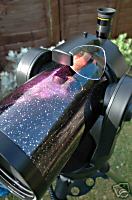 For a premium price, these three ETX's are available in a PE version. This consists of the same optics (different tube), the red dot "smart finder" replaces the optical finder (effective, but breaks easily), a very similar mount, but a much smarter Autostar controller. Courtesy the LNT module, after you turn it on, your ETX will figure out the time, level itself, point itself north, and aim for its first alignment star. You center the two alignment stars and you're off and running. It's fascinating to watch! They save you some time and are very slick to watch, but they're pricey, and can be a little high maintenance.
For a premium price, these three ETX's are available in a PE version. This consists of the same optics (different tube), the red dot "smart finder" replaces the optical finder (effective, but breaks easily), a very similar mount, but a much smarter Autostar controller. Courtesy the LNT module, after you turn it on, your ETX will figure out the time, level itself, point itself north, and aim for its first alignment star. You center the two alignment stars and you're off and running. It's fascinating to watch! They save you some time and are very slick to watch, but they're pricey, and can be a little high maintenance.
**update Feb '07: Along with the discontinuation of the 105, the Premier Edition has been redesigned. Mechanically, it is virtually the same, but cosmetic changes have taken place. The anodised picture on the tube is now gone (thankfully), and the traditional Blue tube has returned. Also, the delicate red dot shield is gone, and is replaced by a standard red dot finder.
Meade 2040-2045:
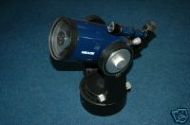 While not an ETX, in some cases this little scope can be mistaken for one, and it is included in this guide really more out of interest. Riding on a table tripod, as the ETX RA does, the main difference is that the 20's were a Schmidt Cassegrain telescope, and not a Mak. Originally appearing in the 80's as the 2040 with a single arm mount and a simple drive in RA. This later evolved into the similar 2044, which then quickly vanished. The 2045 rose from their ashes. This was a stable unit with a double fork mount and table tripod, and this too evolved slightly...until the mid 90's. At this point in time, Meade decided that a small Maksutov would be the next addition to their line up. The 2045 never had a chance, and was quickly, and quietly dropped. You'll notice I've not included a picture, simply because these aren't terribly common scopes, and I've never been able to see/use one that wasn't behind glass (if I get the chance, I will add a picture, meanwhile, a web search will find one for you). While the structure of the mount (non-goto), is considered excellent (all metal), they apparently vary optically, and are considered to be several optical notches below their successor, the ETX.
While not an ETX, in some cases this little scope can be mistaken for one, and it is included in this guide really more out of interest. Riding on a table tripod, as the ETX RA does, the main difference is that the 20's were a Schmidt Cassegrain telescope, and not a Mak. Originally appearing in the 80's as the 2040 with a single arm mount and a simple drive in RA. This later evolved into the similar 2044, which then quickly vanished. The 2045 rose from their ashes. This was a stable unit with a double fork mount and table tripod, and this too evolved slightly...until the mid 90's. At this point in time, Meade decided that a small Maksutov would be the next addition to their line up. The 2045 never had a chance, and was quickly, and quietly dropped. You'll notice I've not included a picture, simply because these aren't terribly common scopes, and I've never been able to see/use one that wasn't behind glass (if I get the chance, I will add a picture, meanwhile, a web search will find one for you). While the structure of the mount (non-goto), is considered excellent (all metal), they apparently vary optically, and are considered to be several optical notches below their successor, the ETX.
** Picture above: This scope would be tilter into a polar alignment using legs in the same way that the ETX 90RA would be. Note the flat corrector plate of the SCT, compared to the steep curve of the Maksutov version.
UHTC coatings:
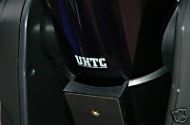 The three largest ETX's are also available with UHTC (Ultra High Transmission Coatings). This is a Meade trademark coating that coaxes approximately 15% more light through the glass than standard coatings. In the UK, UHTC is pretty much standard on the larger ETX's, but it wasn't always this way. While almost always on the 105 & 125, the 90 is regularly seen without UHTC (if in doubt, ask the seller). The only real clue to their presence is a small sticker underneath the tube at the base, Try to get the UHTC if you can, although this can increase the price (approximately 10% to 20% more), but this could vary on auction sites!
The three largest ETX's are also available with UHTC (Ultra High Transmission Coatings). This is a Meade trademark coating that coaxes approximately 15% more light through the glass than standard coatings. In the UK, UHTC is pretty much standard on the larger ETX's, but it wasn't always this way. While almost always on the 105 & 125, the 90 is regularly seen without UHTC (if in doubt, ask the seller). The only real clue to their presence is a small sticker underneath the tube at the base, Try to get the UHTC if you can, although this can increase the price (approximately 10% to 20% more), but this could vary on auction sites!
Can you tell the difference without the UHTC sticker?
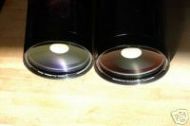 One of the above ETX 90 OTA's has UHTC, the other does not. Notice the slight difference in colour hues (this is only visible in some light, and from some angles): Purple on the left, Red on the right. Can you tell which one is which? Answer at the bottom of this guide!!! There are no prizes if you get it right, sorry...
One of the above ETX 90 OTA's has UHTC, the other does not. Notice the slight difference in colour hues (this is only visible in some light, and from some angles): Purple on the left, Red on the right. Can you tell which one is which? Answer at the bottom of this guide!!! There are no prizes if you get it right, sorry...
Autostar
It's not hype. With all the ETX family, if the scope and Autostar are properly aligned, the Autostar works very well, and will amaze you! Remember to be patient at first, as it may take a few tries and a bit of practice to get a good alignment.
With all the ETX family, they can be polar aligned with a suitable tripod (the Meade Deluxe Field tripod is most common), or used in a standard alt/azimuth (up/down, left/right) configuration. With any option, I will always recommend learning where things are for yourself! Use the Autostar as a bonus, not your saviour. You will find this much more rewarding...and anyway, what happens if the batteries are dead?
How old is it?
How old is the ETX you're considering buying? That's a tough one, as there have been few cosmetic changes in the ETX during their evolution (with the exception of the Premier Edition). Autostar version numbers don't help, as this can easily be updated to the current software. The manual can sometimes help, as the 105 was not pictured on the cover of the earlier versions (but this can be misleading, as it may not be the original manual). There are clues which may help a little, but they are internal and involve a bit of dismantling (a web search can help with this). Having said that, this should really be for you own curiosity only, as I wouldn't ask a seller to tear his telescope apart on my behalf. Please also don't interpret this as a request to dismantle your own telescope!
The Million-Dollar Question: How much does it matter?
In my opinion, I think the ETX ages well. The insides are remarkably simple, and its brains are in the Autostar handset (which can be replaced if necessary). Check the condition, and if you're concerned about it, ask. Is there any impact damage or sign of misuse? Are both motors functioning normally?
Two common issues: 1. Does the RA drive stall or stick? It could be missing gear teeth in the drive (the RA unit can be replaced). 2. Grease can bleed into the friction wheels of the declination axis, causing the tube to slip down ** (this can be cleaned and corrected). Both of these should be easily fixed by your local dealer, but at a price. Has the scope been used recently? If not, why not? If so, how is pointing accuracy? I personally check all this, so don't be afraid to ask questions. If the seller is expecting you to spend £200-300 or more, he/she should really know the answers. Make sure there's a good close up picture of the optics (if not, ask for one). The coatings help them photograph well, but you should be able to make out any major issues. If the seller can't deal with your concerns, and isn't prepared to back up the scope they're selling, then reconsider bidding or buying. Another ETX will come along.
** The declination tube slippage can lead to something more sinister: the locks holding the tube at a vertical angle are simple friction locks. Grease moves around and if excess is introduced into the friction rings, the tube will begin to slip, and gradually keep slipping. The operator may unknowingly crank the dec. lock to counter this, and pressure will build, potentially cracking the main support arm. I've seen two ETX's like this, both 90's, and both on Ebay. The first sold honestly (I bought it...my first Ebay purchase!), the second sold with a "cosmetic flaw"...ouch. I contacted the seller of the second, in case they were unaware of the problem? The listing remained unchanged and was bought by someone...Hmm, buyer beware indeed. The crack shows at the very top of the arm, and can sometimes look like a flaw in the plastic. This can only be repaired by a complete replacement of the upper support arm (if you can find one), and this is a pain! If you see one of these, unless you can get it as a bargain (!) DIY project, stay away from it. A rare issue, but one to watch for.
How many owners?
An interesting one. I think this is personal... I have to admit, this doesn't matter to me personally. If the scope (regardless of model) has been abused this should show, and alarm bells should ring. One owner, two owners, more? If the owners used care, other than potential warranty transfer, what difference does this make? Chances are, numerous hands and eyes will have used it for looks at the Moon, Saturn etc. in back gardens and star parties anyway. I wouldn't get too hung up on this. If the owner(s) have cared for it, it won't matter.
But it's plastic?!
Yes, the arms supports are made of plastic. If you were to dismantle the ETX, you may find the supports appear a little insubstantial looking... Rest assured, the ETX was designed to be entirely capable of supporting the weight of its' tube. Once all the parts of the ETX are attached together, the unit works as one interlocking piece, and it is perfectly solid.
Some things to remember:
- Astrophotography: Well, not really. The mount is just not accurate enough for long exposure photography. A web-cam is ok, and depending on the weight, you can piggyback a camera for some wide field shots (where precise tracking is not so crucial). Keep in mind, a heavy camera will put strain on the motors of your ETX.
- An ETX will only be suitable for 1.25 eyepieces.
- Lots and lots (& lots) of accessories have been made for the ETX: it is a marketing dream come true! Get a dew shield (the soft one is much easier to store) and a Barlow lens (1.25 short barrel), then use it for awhile before you start shopping. If you can't wait, get a flexi focus cable (all models), the right angle finder (for the 90), and an “alignmate” (combined bubble level and compass that pops into the eyepiece holder and makes aligning much more acccurate). These should start you off nicely.
I hope this guide is of some use. Please feel free to contact me if you have any questions, or feel I've missed something in this guide. I don't pretend to know everything, but I will always try to help.
Contact me here (demunge the address first)
PS. Did you spot the difference?
The tube on the left is a Premier Edition OTA, and has UHTC. The tube on the right was an original EC and has standard coatings.
Thanks,
Intergalacticwanderer (Richard)
About the author
Richard Day runs Skylight Telescopes, and is an authorised Meade dealer. He also specialises in pre-owned equipment and trades on Ebay using the name “intergalacticwanderer”. All the telescopes he sells are tested thoroughly before being advertised or offered for sale, and his first Ebay purchase was an ETX-90EC!